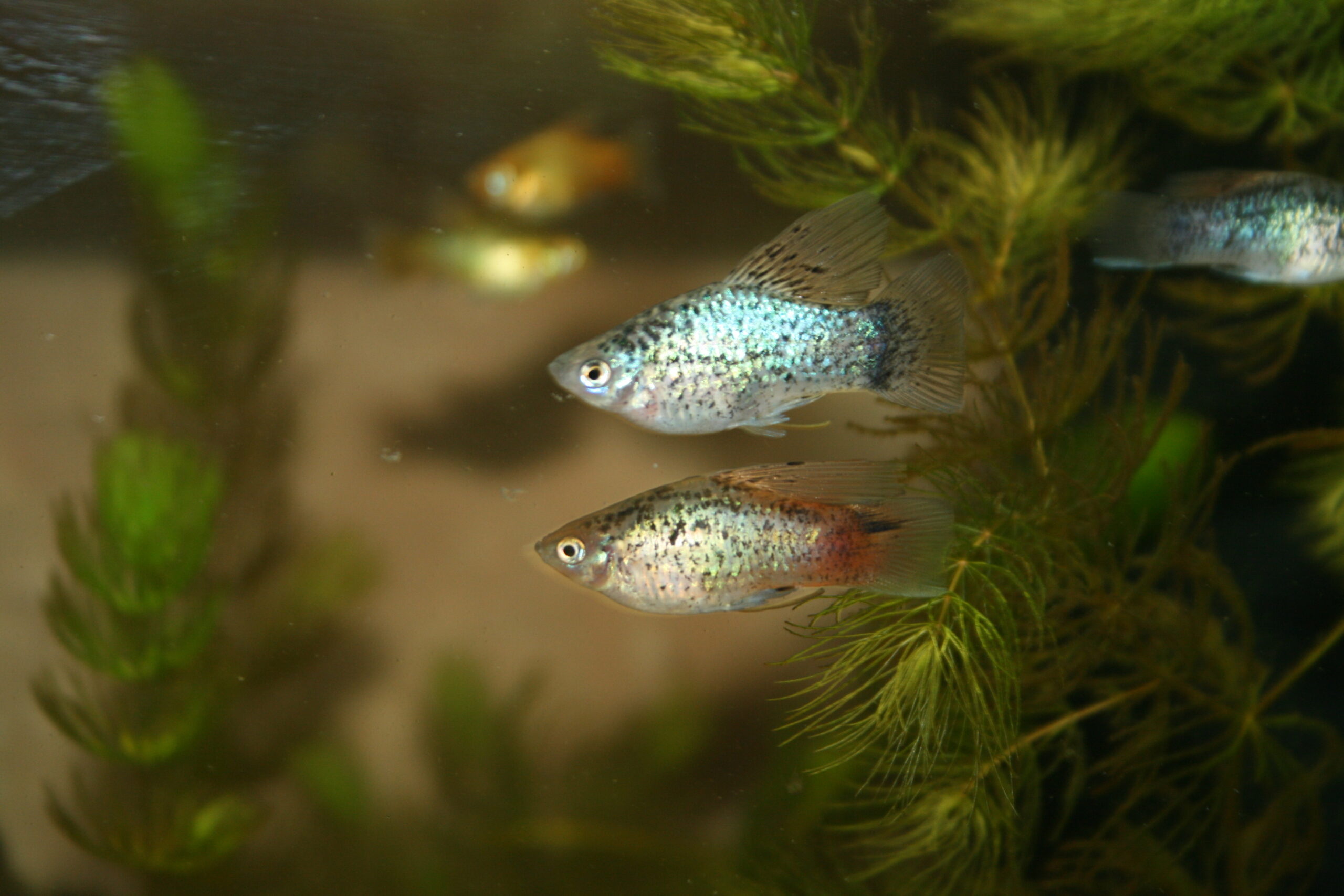I recently sent off a column to Tropical Fish Hobbyist (TFH) magazine about a strain of Hifin Platies we have that breeds true. For those of you who don’t know, the hifin gene is a homozygous lethal in swordtails and platies. Fish that inherit two hifin genes, one from each parent, die as embryos. As a result, it’s not possible to develop a true breeding hifin strain.
But, we have a true breeding hifin, our Freckle Hifin Variatus. You can read my TFH column when it comes out for details. In that column I promised to conduct some genetic tests suggested by Dr. Roy Levine to work out the inheritance of our hifin gene. To that end, I just set up five Freckled Hifin males with the following females:
- 6 – Maculatus ‘Redwag Plumetail’
- 6 – Maculatus ‘Gold Mickey Mouse’
- 5 – Maculatus ‘Blue Opal’
- 1 – Maculatus ‘Blue Opal Hifin’
- 6 – Variatus ‘Redtail Blue Tuxedo’
- 1 – Variatus ‘Sunset Hifin’
I choose each of these strains because I know I can pick out hybrids because I know the genetics of each strain. This way I don’t have to spend three months raising virgin females (usually necessary since female platies can store sperm from previous matings). I will break down the vat in four weeks and discard the fry since they will be from previous matings. I’ll separate each of the six types into their own vats. The next batch of fry they have should be from the Freckled Hifin males since new sperm seems to mostly replace old, stored sperm. I’ll be able to separate out the hybrids from any non-hybrids by looking at them.
A couple of quick examples of who this works: the Blue Opal coloration is a recessive gene. To be Blue Opal, a fish must be homozygous; it must inherit two copies of the gene. The male Freckled Hifins don’t carry that gene. Their offspring can be Blue Opals. Therefore, any hybrid offspring of the Blue Opal females will not be Blue Opal colored. This is also true of the gold color of the Gold Mickey Mouse fish. The hybrids will not be gold since that is a recessive characteristic. Each of the other strains have genetic markers that will let me easily determine if the fish are hybrids or not.
The fish in the photo are two of the male Freckled Hifins I set up with the mixture of females.


Karl Trochu says
Glenn Takeshita from Hawaii described the same occurrence but with hi-fin variatus platies and wrote an article in TFH as well titled “A Homozygous Hifin Variatus?” (August 2001).
As per my own experience, I have never bred any true breeding hi-fin xyphophorus. All my hi-fin lines do produce low-fin offspring along with hi-fin. Very interesting development indeed. Karl
charles says
Karl – Yes, I’m aware of Takeshita’s article. In fact, there is an upcoming column
of mine in Tropical Fish Hobbyist magazine that covers our fish also
mentions Takeshita’s fish and article. Dr. Roy Levine also once had a
true-breeding line of hifin swordtails. According to Levine, Takeshita and
he no longer have their strains. In fact, he emailed me saying, “As far as I
know, you are the only one that has true-breeding hifins.”
The interesting thing about our line is that we get about 1% low fins each
generation. That could be because we group breed, usually 6 males with 40-50
females. If this hifin gene is dominant, it is possible there are some
recessive low fin genes floating around in the population and occasionally a
homozygous low fin fish appears. Or it could be incomplete penetrance or
even other genes causing it. That’s why Dr. Levine wants me to do some
controlled breeding. Unfortunately, the “correct” way to do this is to raise
virgin females to do the test matings. Raising virgin platy and swordtail
females is a pain and doesn’t work well in our system. I’ve lost an entire
vat of virgins by failing to check for males often enough. So, I’ve devised
test crosses with genetic markers so I can identify the hybrids easily.
I’ll keep y’all posted on the results.